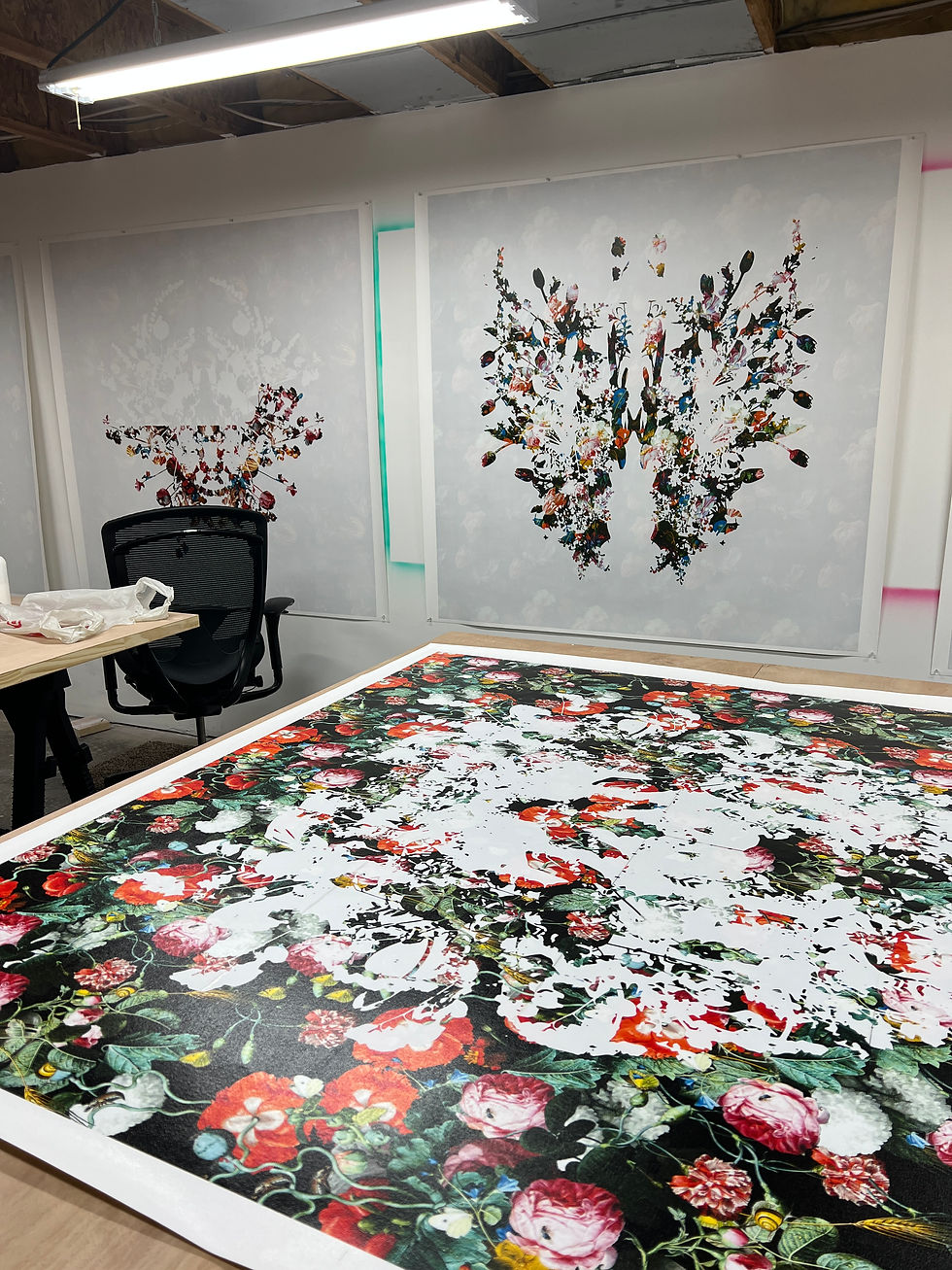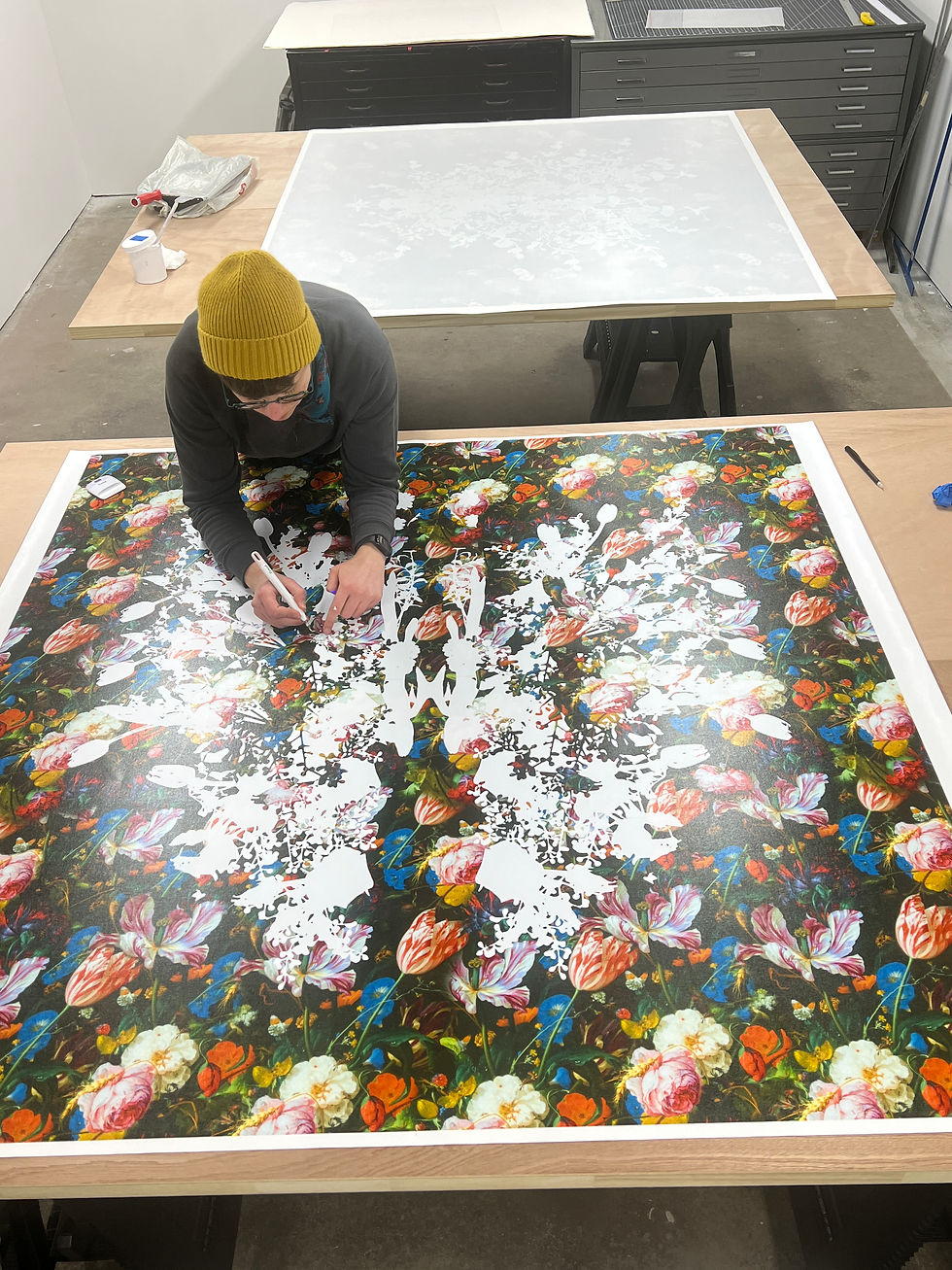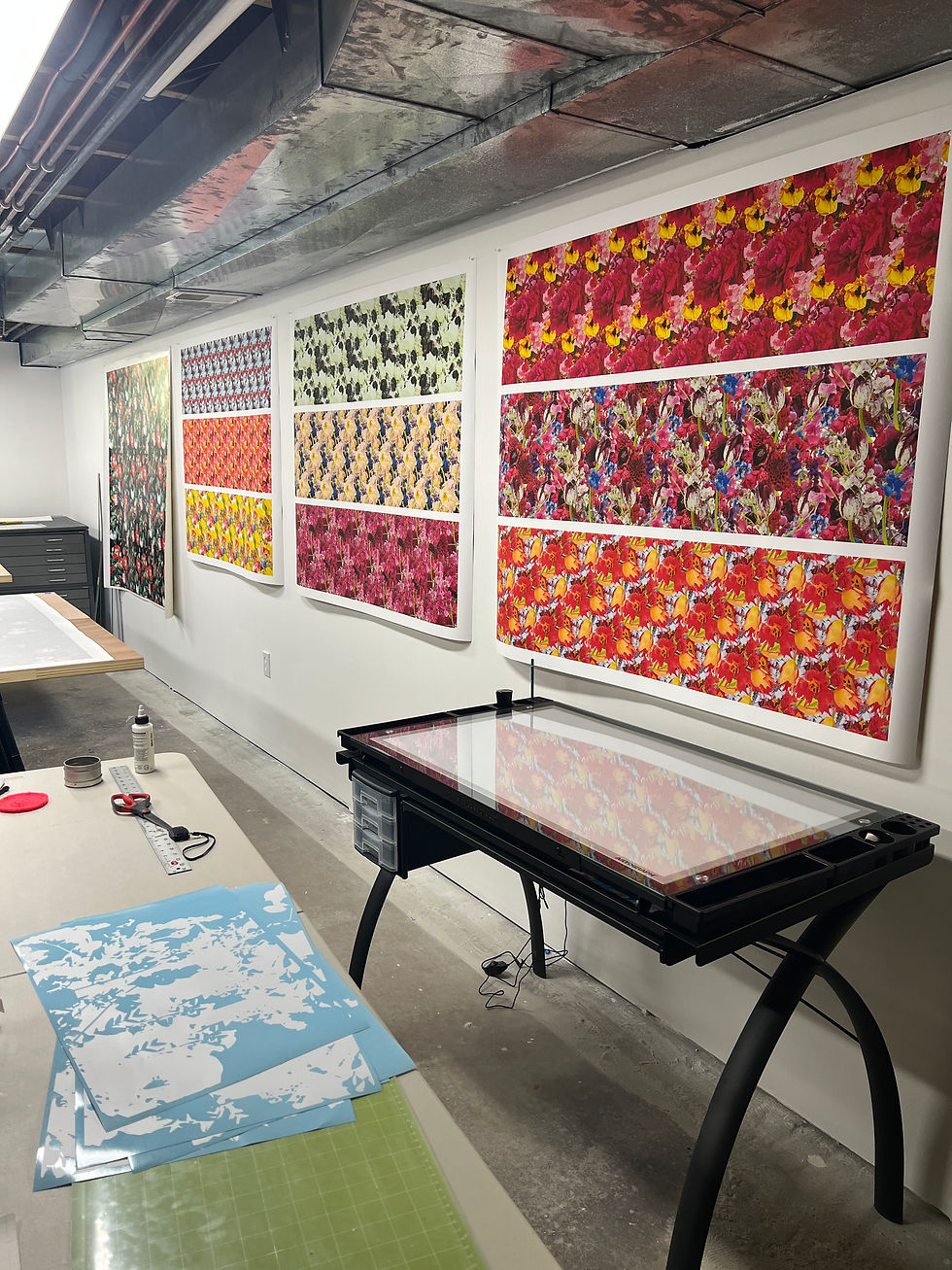12 Questions: J Myszka Lewis
- James May Gallery

- Jan 12, 2024
- 7 min read
#artistblog #wisconsinartist #contemporaryprintmaking #artgallery #artistlife #creativelife #milwaukeegallery #wisconsingallery #printmaking #tandempress #poeticsofspace #studioviews #dutchstilllife #floral
Artist Biography
J Myszka Lewis received her BFA from the University of Wisconsin-Milwaukee in 2011 and her MFA from the University of Wisconsin-Madison in 2015. She has participated in many group exhibitions at places such as the International Print Center New York (New York, NY), Charles Allis Art Museum (Milwaukee, WI), Soap Factory (Minneapolis, MN), Museum of Wisconsin Art (West Bend, WI), Trout Museum of Art (Appleton, WI), and the Chazen Museum of Art (Madison, WI). She has participated in residencies at the Jentel Foundation in Banner, Wyoming and the Kimmel Harding Nelson Center for the Arts in Nebraska City, Nebraska. She has been a finalist for a Luminarts Cultural Foundation Visual Arts Fellowship, the Hopper Prize, and the Forward Art Prize. In 2018, she received the Edna Wiechers Art in Wisconsin Award from the University of Wisconsin-Madison’s Division of the Arts. J Myszka Lewis is based in Madison, Wisconsin.
Artist Statement
In my practice, I use print media, embroidery, and painting to explore various concepts that stem from considerations of pattern and repetition. In my current work, I deconstruct and repeat floral imagery in drawings, paintings, and prints to discuss ornament, impermanence, and the comfort found in repetition. I manipulate found floral images using methods of scanning, stenciling, and duplicating to create exploding Rorschach-like symmetrical abstractions, tangled gardens, and lacey silhouetted botanical forms.
This work combines imagery sourced from 17th-century Dutch still-life paintings with aesthetic and conceptual concerns of the Pattern and Decoration movement which emerged in the mid-1970s and championed decorative and craft-based aesthetics as equal to figuration, minimalism, and conceptualism in art. The Dutch flower paintings that inform my work depict lavish bouquets as objects symbolic of prosperity and abundance. In our contemporary context, I consider flowers as representative of any number of things we value—things that are lovely, precious, and often times fleeting. They are quintessential expressions of beauty and temporality.
Flowers’ brief lifespans serve as condensed depictions of our mortality. Just as they bud, bloom, wilt, and sprout up again, cycles of patterns appear throughout our lives as routines, reoccurring activities, and anniversaries of dates past (which are often celebrated or remembered with flowers). We are drawn to and adapt to these rhythms, and yet each iteration of a repeated event or task is slightly different than the last. My work celebrates patterns’ affinity for consistency and predictability while acknowledging that changes and variability can also emerge through repetition. Visual tensions and harmonies develop as I combine and reconcile multiple patterns with each other. In my more linear works, the repeated imagery shifts and changes as the layered patterns interact across the painting.
By masking areas, I also consider how our relationship with what is absent is nearly as strong as our relationship with what is present. The complexity of the patterns in my work beg the viewer to search for details and inconsistencies throughout the repeated motifs. Conveying multiplicities of flowers’ symbolism, this work means to incite curiosity, introspection, and meditation.
1. What are 1-3 books that have influenced your life?
Two books come to mind immediately: The Poetics of Space by Gaston Bachelard and Bluets by Maggie Nelson. They don’t have any obvious direct influences on my current work, but they deeply impacted me the first time I read them. Their general sentiments and way of looking at our environments and experiences has had a lasting impact on my work as an artist. I haven’t read them in years, but I think it’s time to revisit them again.
2. What are you currently working on?
More similar work to what is included in the “Passionate Realities” exhibition. I’m working on a group of large stenciled paintings now that continue the work I began in 2023. In these new pieces, I’m playing around with the repeat of the patterns more, breaking away from the symmetrical Rorschach-esque compositions a bit. I’m also developing the repeated patterns and forms through multiple layers of stencils to further consider ideas about time, and I’ve exaggerated the color palettes in a few of them to some deep night-time hues. I think these short winter days we are experiencing now had a role in that move. Some of these new pieces will be shown this spring in one of the galleries at the Overture Center in Madison, Wisconsin.

3. How has failure set you up for later success? What was your favorite failure?
Oh my gosh, I clean my studio every couple of years and always find myself throwing out so many test pieces that never amounted to anything. For every series that I develop, there must be at least five other ideas that never made it out of the studio. When I am purging them from my space, these experiments or sketches can sometimes feel like a bunch of wasted time and materials, but I know that these failures are a necessary part of my studio practice. I think by making, and I learn from everything I make, even the failures.
4. What is your most unusual habit?
5. If you could have any painter, living or dead paint your portrait who would it be and why?
I’m not sure why, but I’m feeling drawn to answer this question with abstract painters! I would love to see what sort of grid painting Agnes Martin would come up with to represent me. Or I think it would be fun to have my likeness obliterated by polka dots if Yayoi Kusama wanted to have a go at it.
6. What is the most indispensable item in your studio/workspace/office? What is your studio like? Could you share an image?
Most of my work begins digitally. I don’t use a sketchbook in the traditional sense; instead, I mock up ideas in Photoshop and Illustrator. So I’d have to say that my computer is indispensable. My Cricut machine also deserves a mention. I use it to cut all the vinyl stencils I use to mask areas in my paintings, many of which would be impossible to cut by hand! My studio is in the basement of my home, and I love being able to pop in whenever I have time. I work on unstretched canvas, sometimes flat on large tables, and sometimes vertically on the wall. I like to use hollow doors and saw-horses as modular tables that I can set up in different configurations and also break down when more floor space is needed.

7. When you feel overwhelmed or uninspired what do you do? What do you do to get out of a funk? What questions do you ask yourself?
I went through a huge creative block in 2020 (thanks Covid). I felt that I had come to an endpoint with what I had been working on for the past eight years, but I didn’t know what to do next. As I tried to get back to work, I challenged myself to make work about nothing, which is of course impossible. But, while I thought about this idea of making work about nothing, I was forced to rethink what I had been working on, what lines of thought I wanted to continue to investigate, and what I was interested in that I had not yet approached in the studio. When I’m getting stuck in the studio, I also like to look to art history. I turn to the masters and think about what led them to make the work they are most known for. I’ve realized that simple thoughts or questions laid the groundwork for many movements throughout art history, and this prompts me to return to focusing on the basic thoughts that propel my work.
8. Who/What influences your work?
Currently, 17th-century Dutch still-life paintings and the Pattern and Decoration Movement that began in the mid-1970s both have huge influences on my work. I also find sparks of inspiration strike during more unexpected moments—through conversations with other artists about their work, when reading poetry (which I don’t do that often, but sometimes when trying to come up with titles), and when just out for a walk and letting my mind wander.
9. Do you collect anything?
I have a few half-hearted collections. I swing back and forth between being a packrat, and then every few years I get an intense need to purge unused possessions. I do have two collections that I have yet (and don’t plan) to dismantle though. My husband and I love camping and hiking, and we have a collection of patches from national and state parks we’ve visited. I also collect art. I love to buy pieces from artists I admire when I can afford to, and I’ve participated in many portfolios and trades. I can’t imagine not living with art in my home!
10. What words of advice would you give to your younger self?
It’s okay to take breaks! (Although, I still often need this reminder.) And although you are making the best work you can make right now, you will make even better work later, so don’t get too precious about it all.

11. In the last five years what new belief, or habit has most improved your life or studio practice?
Sticking to a schedule and getting a dog (or two). The pups make sure I take those necessary breaks.
12. Share an inspiring image.
My husband and I had the chance to travel to Zambia this past year to visit where my brother and his family live. Being immersed in a different culture makes you reconsider a lot of things. They took us to one of the markets where the locals shop (no tourists in sight), and I found it so hard to leave the kitenge cloth shop without buying everything! The colors and patterns there were amazing.

James May Gallery | 2201 N Farwell, Milwaukee, WI | 262-753-3130
PASSIONATE REALITIES featuring J Myszka Lewis, Lorn Ritz, Lydia Dildilian, & Mark Bowers runs until Feb 24th.
See more of Myszka's work and follow her here: ARTSY
See what is happening at the gallery:
Please continue to support us by visiting us in person at our new location: 2201 N Farwell Ave, Milwaukee or check out our Artsy page.
Feel free to contact us:
mail@jamesmaygallery.com 262-753-3130
HOURS: Tues-Thur 10:30-5:30 Fri 11- 5:30 Sat 10:30-5:30









f
Discovering Romance: A Guide to Finding Love in the Escort Industry
In the bustling heart of Los Angeles, where dreams come alive and boundaries blur, an unconventional avenue for romance has emerged: the escort industry. While many view this profession through a lens of taboo and misconception, it can also be a place where genuine connections and meaningful relationships blossom. This guide aims to shed light on the potential for love and companionship within the world of female escorts near Los Angeles.
Understanding the Escort Industry
Before diving into the realm of romance, it's essential to understand the escort industry's intricacies. Los Angeles escorts offer companionship, intimacy, and entertainment services for clients seeking a variety of experiences. Contrary to common…